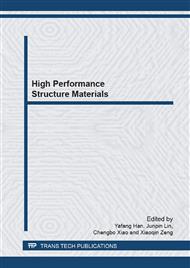p.377
p.383
p.390
p.398
p.404
p.412
p.421
p.426
p.431
Numerical Simulation Research on Wide Casting Nozzle of Twin-Roll Magnesium Alloy
Abstract:
Casting nozzle structure is the decision factor for the formation process of the fluid field of magnesium alloys melt, and the distribution uniformity of the casting nozzle has an important influence on the process stability and the billet quality. In this research, the casting nozzle structures used in producing AZ31 magnesium alloys slab with width of 1500 mm by using horizontal twin-roll continuous casting were taken as research object, and the fluid field of magnesium alloy melt in different casting nozzle structures were simulated, and the influences of the numbers, position, shape and size of the divergent fluid block on the fluid velocity were analyzed. The results show that the fluid velocity distribution obtained by seven divergent fluid blocks were superior to five or three divergent fluid blocks, the streamline divergent fluid blocks were superior to the linear ones, and the small divergent fluid blocks were superior to big ones. At the same time, a new casting nozzle structure was presented, the difference between the maximum and minimum fluid velocity by using the new casting nozzle was 4.69%, and the distribution uniformity of fluid velocity meets the requirement of production.
Info:
Periodical:
Pages:
404-411
Citation:
Online since:
February 2013
Authors:
Price:
Сopyright:
© 2013 Trans Tech Publications Ltd. All Rights Reserved
Share:
Citation:


